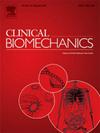Drop landing between subjects post anterior cruciate ligament reconstruction and uninjured controls: A biomechanical and neuromuscular analysis
IF 1.4
3区 医学
Q4 ENGINEERING, BIOMEDICAL
引用次数: 0
Abstract
Background
The capacity of functional testing to identify ‘at-risk’ landing strategies in return to sport evaluation has been questioned. The purpose was to evaluate if biomechanical and muscle activation patterns differ during a drop landing task in subjects post anterior cruciate ligament reconstruction against uninjured controls.
Methods
22 subjects within two years of anterior cruciate ligament reconstruction who had returned to sport and 25 activity matched controls were recruited. Sagittal plane knee and hip biomechanics and muscle activation amplitudes were recorded during a single leg drop landing task. Discrete measures derived from waveforms were analysed using t-tests and Analysis of Variance models (=0.05).
Findings
Subjects post anterior cruciate ligament reconstruction displayed reduced knee (Effect Size = 1.2) and hip (Effect Size = 0.995) range of motion as well as reduced knee extension moments (Effect Size = 0.955) but exhibited no differences in quadriceps or hamstrings activation amplitudes versus uninjured controls.
Interpretation
Adoption of reduced knee and hip excursion or “stiffened” landing pattern despite similarities in muscle activation suggests the presence of adaptive strategies reflecting incomplete recovery despite receiving clearance for returned to sport. This suggests presence of altered patterns of movement which may place at increased risk for reinjury.
前交叉韧带重建后受试者与未受伤对照组之间的降落:生物力学和神经肌肉分析
在运动评估中,功能测试识别“风险”着陆策略的能力一直受到质疑。目的是评估前交叉韧带重建后受试者与未受伤对照者在降落任务中的生物力学和肌肉激活模式是否不同。方法招募22名前交叉韧带重建两年内恢复运动的受试者和25名活动匹配的对照组。在单腿落地任务中记录了膝关节和髋关节矢状面生物力学和肌肉激活幅度。采用t检验和方差分析模型(α=0.05)对波形离散测度进行分析。研究结果:前交叉韧带重建后的受试者显示膝关节(效应值= 1.2)和髋关节(效应值= 0.995)活动范围缩小,膝关节伸展力矩减小(效应值= 0.955),但与未受伤的对照组相比,股四头肌或腘绳肌的激活幅度没有差异。尽管肌肉激活相似,但采用膝关节和髋关节减少偏移或“僵硬”着陆模式表明,尽管接受了恢复运动的许可,但存在反映不完全恢复的适应性策略。这表明存在改变的运动模式,这可能会增加再损伤的风险。
本文章由计算机程序翻译,如有差异,请以英文原文为准。
求助全文
约1分钟内获得全文
求助全文
来源期刊

Clinical Biomechanics
医学-工程:生物医学
CiteScore
3.30
自引率
5.60%
发文量
189
审稿时长
12.3 weeks
期刊介绍:
Clinical Biomechanics is an international multidisciplinary journal of biomechanics with a focus on medical and clinical applications of new knowledge in the field.
The science of biomechanics helps explain the causes of cell, tissue, organ and body system disorders, and supports clinicians in the diagnosis, prognosis and evaluation of treatment methods and technologies. Clinical Biomechanics aims to strengthen the links between laboratory and clinic by publishing cutting-edge biomechanics research which helps to explain the causes of injury and disease, and which provides evidence contributing to improved clinical management.
A rigorous peer review system is employed and every attempt is made to process and publish top-quality papers promptly.
Clinical Biomechanics explores all facets of body system, organ, tissue and cell biomechanics, with an emphasis on medical and clinical applications of the basic science aspects. The role of basic science is therefore recognized in a medical or clinical context. The readership of the journal closely reflects its multi-disciplinary contents, being a balance of scientists, engineers and clinicians.
The contents are in the form of research papers, brief reports, review papers and correspondence, whilst special interest issues and supplements are published from time to time.
Disciplines covered include biomechanics and mechanobiology at all scales, bioengineering and use of tissue engineering and biomaterials for clinical applications, biophysics, as well as biomechanical aspects of medical robotics, ergonomics, physical and occupational therapeutics and rehabilitation.
 求助内容:
求助内容: 应助结果提醒方式:
应助结果提醒方式:


